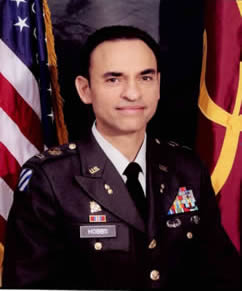Chief Warrant Officer 5
Harry L. Hobbs
 Harry L. Hobbs was born on July 7, 1960 in Louisville, Kentucky. Upon joining the Army in 1978, he served as a field artilleryman and later as a Land Combat Missile Systems Repair Supervisor.
Harry L. Hobbs was born on July 7, 1960 in Louisville, Kentucky. Upon joining the Army in 1978, he served as a field artilleryman and later as a Land Combat Missile Systems Repair Supervisor.
After being inducted into the Sergeant Morales Club and receiving an early promotion to Sergeant First Class in 1987, he received a Warrant Officer appointment. Following graduation from the Land Combat Missile Repair Technician Course, Hobbs was assigned as a Missile Systems Warrant Officer Technician to the 124th Support Battalion, 2nd Armored Division at Fort Hood, Texas. His next assignment was with the 26th Support Battalion, 3rd Infantry Division with which he participated in Operation Desert Storm and Operation Desert Shield where he was awarded the Bronze Star and received a life time induction into the V Corps Distinguished Leader’s Club.
In 1992, following his assignment in Germany, Hobbs served as a Training, Advising and Counseling (TAC) Officer with the 145th Aviation Regiment at Fort Rucker, AL and trained Warrant Officer Candidates during their initial phase of training.
Upon returning to Germany in 1995, he was assigned to the 563rd Ordnance Company Meisau, Germany, where he provided direct and general support to the Combat Equipment Group, Prepositioning of Material Configured in Unit Sets (POMCUS) and the 21st Theater Army Area Command (TAACOM), V Corps and 71st Ordnance Company. During his assignment, he deployed forward to Kaposvar, Hungary in support of Operation Joint Endeavor under the flag of the 29th Support Group. His primary mission was to execute the Reception, Staging and Onward movement of troops and equipment into Bosnia and Herzegovina as the railhead officer-in-charge.
Hobbs’ next assignment was the 801st Maintenance Battalion at Fort Campbell, KY, supporting the 1st Brigade of the 101st Airborne Division beginning in 1996. During this tour of duty, he was elevated to Missile Material Officer for the Division Support Command to work in the Division Materiel Management Center as the Fleet Manager for over 30 fleets of equipment within the division. He was noted for having the highest fleet readiness in recent history at the 101st Airborne Division.
In recognition of his management and leadership skills, in 1999, the Army returned Hobbs to Fort Rucker, AL, as Staff Course Manager and Instructor at the Warrant Officer Career Center. In this position, he trained senior Warrant Officers in ethics, army leadership, and doctrine.
In May 2002, Hobbs was chosen as the Detachment Commander for the Ordnance Training Detachment at Fort Sill, OK; the only active duty Chief Warrant Officer serving as a Detachment Commander in the Army. As the commander for the Army’s Radar Repair School, he was responsible for training Soldiers in Army Initial Training (AIT), the Warrant Officer Basic Course, and the Warrant Officer Advance Course.
Following a tour at Aberdeen Proving Ground as a Personnel Proponency Officer for the 61st Ordnance Brigade, he travelled to Redstone Arsenal in 2005 to be the Warrant Officer Personnel Proponency Officer for the 59th Ordnance Brigade. During his tenure, he reviewed and updated the Points of Instruction for all 14 missile and electronic Military Occupational Specialties in the Army. As well, he met all Ordnance Warrant Officer accessions, retention, and mentorship goals, while realigning the Ordnance Warrant Officer Corps to meet Army transformation and modularity requirements.
Chief Warrant Officer Five Harry L. Hobbs retired on August 31, 2007.